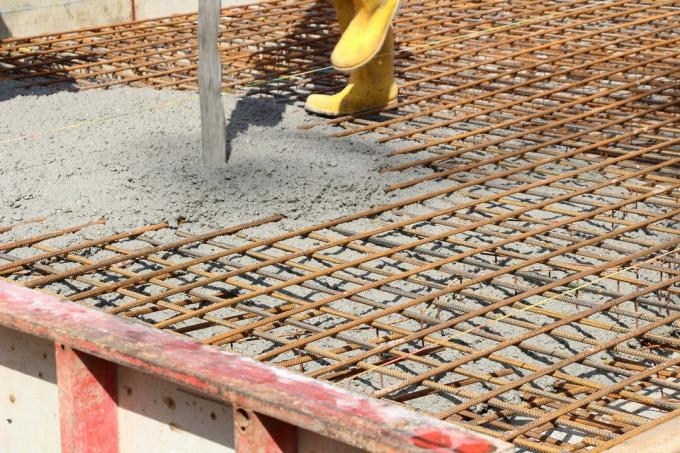
contents
- density or weight?
- Light concrete
- normal concrete
- heavy concrete
- frequently asked Questions
Anyone who builds with concrete should know the weight of a cubic meter (m³) in order not to experience any nasty surprises in construction projects. In our article we tell you how many kilograms 1 m³ of different types of concrete weighs.
In a nutshell
- density or Weight depends on the type of concrete
- is dry density
- Lightweight concrete up to 2,000 kg/m³
- Normal concrete up to 2,600 kg/m³
- Heavy concrete from 2,600 kg/m³
density or weight?
First of all: The density and the weight of a cubic meter of concrete describe the same value in general usage. They indicate how heavy a cubic meter of concrete is in kilograms, which allows you to easily determine the total weight of a foundation, for example. Of the two terms, density is the most commonly used. These are guide values, which are based on the weight of the individual parts mixing concrete put together:
- 1 part cement
- 4 parts surcharge
- water

The density differs depending on the type of concrete, as different aggregates and additives are used. These are specified via DIN 1045 (supporting structures made of concrete, reinforced concrete and prestressed concrete) in part 2 (concrete – specification, properties, production and conformity). These include the following types of concrete:
- lightweight concrete
- normal concrete
- heavy concrete
A notice: The values given are the dry density of the concrete per cubic metre. When planning, note that the dry density always indicates the specific weight after the concrete has dried and hardened.
Light concrete
Lightweight concrete has the lowest density compared to the other types of concrete. More porous aggregates are used for mixing, which make the concrete lighter, which also has a positive effect on the thermal insulation properties. These aggregates include, for example:
- pumice
- expanded glass
- expanded slate
- expanded clay
- lava rock

This gives lightweight concrete a density of 800 to 2,000 kilograms per cubic meter. Technically possible is even 350 kilograms per cubic meter. The following types of concrete belong to lightweight concrete:
- Structurally dense lightweight concrete
- No-fines lightweight concrete
- infra-lightweight concrete
- aerated concrete
- pumped concrete
- foam concrete
normal concrete
Normal concrete describes a large part of the classic types of concrete that are used in house construction, for example. Their density is between 2,000 and 2,600 kilograms per cubic meter. A typical example of normal concrete is dry concrete, which has a density of 2,000 kilograms per cubic meter. Classic aggregates such as sand, gravel, grit or crushed stone are used, which make the concrete heavier. Normal concrete is most commonly used in the following areas of application due to its high compressive strength thanks to the aggregate:
- House construction (cleanliness layers)
- landscaping
- road construction

A notice: Reinforced concrete is a normal type of concrete and weighs 2,600 kilograms per cubic metre. This is the heaviest concrete in this category.
heavy concrete
Heavy concrete describes all types of concrete that have a density of at least 2,600 kilograms per cubic meter. Due to their high density, the concretes are primarily used in radiation protection, for example to shield X-ray systems or reactors. They are rarely used in the private sector.
frequently asked Questions
Screeds with the usual grain size of 0 - 8 mm belong to the normal concretes and have an average density of 1,900 kilograms per cubic meter. The weight may differ slightly for screeds with a different grain size.
A part of cement is always needed for concrete. Concrete is mixed from 5 parts, of which the 4 other parts are aggregates. That means you need to divide the density of the cubic meter by a factor of 5 to get the total amount of cement needed. With a normal concrete with a density of 2,500 kg per m³ you need 500 kg of cement for each m³.
To do this, you take the volume of the element, such as a foundation, and multiply it by the density of the concrete in question. With a foundation made of normal concrete (2,400 kg) measuring 5 m x 5 m x 0.1 m (= 2.5 m³), you arrive at a total weight of 6,000 kg.


